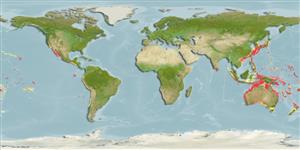Environment: milieu / climate zone / depth range / distribution range
Ecología
marino bentopelágico; rango de profundidad 50 - 200 m (Ref. 11230). Subtropical
Southeastern Indian Ocean, western Pacific, antitropical.
Tamaño / Peso / Age
Maturity: Lm ? range ? - ? cm
Max length : 35.0 cm TL macho / no sexado; (Ref. 9137); 25.0 cm TL (female)
Espinas dorsales (total) : 10; Radios blandos dorsales (total) : 19 - 21; Espinas anales: 3; Radios blandos anales: 7 - 8; Vértebra: 26. Orange-red with black spots on the base of the dorsal fin (Ref. 43805). Congruent rays of the dorsal fin and a caudal fin rounded at the end, without a deep median notch, with only slight notches above and below in males, and with a very weak median notch in females (Ref. 43805).
Occurs inshore near reefs (Ref. 7300), on sand or rock bottom (Ref. 11230). Benthic and benthopelagic on hard substrates (Ref. 58302). Consumed as food (Ref. 559).
Life cycle and mating behavior
Maturities | Reproducción | Spawnings | Egg(s) | Fecundities | Larva
Kharin, V.Y. and V.A. Dudarev, 1983. A new species of the genus Caprodon Temminck et Schlegel, 1843 (Serranidae) and some remarks on the composition of the genus. J. Ichthyol. 23(1):20-25. (Ref. 43805)
IUCN Red List Status (Ref. 130435)
Threat to humans
Harmless
Human uses
Pesquerías: comercial
Herramientas
Special reports
Download XML
Fuentes de Internet
Estimates based on models
Preferred temperature (Ref.
123201): 14.5 - 27.6, mean 23.3 °C (based on 380 cells).
Phylogenetic diversity index (Ref.
82804): PD
50 = 0.6250 [Uniqueness, from 0.5 = low to 2.0 = high].
Nivel trófico (Ref.
69278): 3.4 ±0.45 se; based on food items.
Resiliencia (Ref.
120179): Medio, población duplicada en un tiempo mínimo de 1.4-4.4 años (Preliminary K or Fecundity.).
Fishing Vulnerability (Ref.
59153): Low vulnerability (25 of 100).
